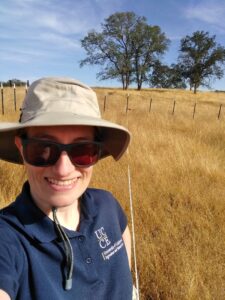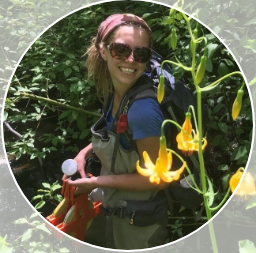Apply now to join our next cohort of Community Science Fellows and Community Leads!

Photo courtesy of Sierra Foothills Conservancy
Blue oaks are a native tree species key to the health and function of California rangelands, which in turn mitigate climate change and provide clean air, water, food, and fiber. The Sierra Foothills Conservancy will use Blue oak monitoring data collected at Mckenzie Table Mountain Preserve to affect broadscale ecosystem management decisions and educate local land managers.
The Sierra Foothill Conservancy (SFC) is a local, non-profit land trust located in the Sierra Nevada Foothills in Central California. SFC manages and conserves expansive landscapes, important habitats, and clean water resources from the snow-capped Sierra to the Central Valley floor. SFC supports a thriving land-based economy while promoting a conservation ethic focused on managing natural resources in the region.
Blue oaks are native to the central California foothills and are an indicator species for ecosystem function, as they provide wildlife habitat, promote biodiversity, and increase carbon sequestration rates, water infiltration, and soil moisture retention. Healthy blue oak populations also provide many societal benefits for rural communities whose livelihoods depend on ecosystem function, and downstream ecosystem services such as clear air and water, climate regulation, and recreational opportunities.
Regeneration and persistence of blue oaks has long been a challenge on California rangelands, largely due to climate change stressors and impacts from grazing pressure. Many landowners and managers wish to conserve blue oaks for the benefits they provide, but there is a lack of research and technical advice available on implementing beneficial grazing strategies and best practices for promoting healthy ecosystem function. Since 2014, SFC has been implementing regenerative grazing practices at the McKenzie Preserve to better understand best practices for regenerating and conserving Blue oaks. SFC is interested in collecting quantitative evidence on how blue oak populations are responding to these regenerative practices compared to sites that have received less active management to share findings and recommendations with local stakeholders and increase awareness of beneficial rangeland management practices.
Sierra Foothill Conservancy (SFC) is working with the National Ecological Observatory Network and University of California Cooperative Extension to implement a one-year monitoring study comparing regenerative and traditional grazing practices at the McKenzie Table Mountain Preserve. The study will assess differences in blue oak health, abundance, phenology, and biomass accumulation. Monitoring protocols will be modeled after NEON vegetation protocols, and the results from this study will be summarized in conjunction with data collected on blue oaks at nearby NEON and UCCE sites, to inform future management practices on SFC-managed land, and to create educational resources to distribute to local stakeholders.
Upon completion of the monitoring study, SFC, NEON and UCCE will host a field day for local landowners, natural resource managers, agency personnel, livestock producers, university students, SFC members, and other non-profit and NGO stakeholders. The field day will include distribution of educational materials on blue oaks, ecosystem functioning, and the practical application of regenerative agriculture practices. Additionally, the field day will provide hands-on training for oak monitoring technique and a presentation of findings from this study and resources available for rangeland management. Furthering stakeholder education on enhancement of Blue oak woodlands can impact the bottom line of livestock producers, accomplish ecological objectives of resource managers, and enable all land managers to provide ecosystem services and resilience to climate change.
The full project timeline will take place from June 2022 – May 2023.
Billy Freeman serves as Rangeland Manager Sierra Foothill Conservancy (SFC) and has worked for the organization since November 2011. Billy is a California Certified Rangeland Manager and a Certified Professional in Rangeland Management. Billy manages the grazing programs on SFC’s 8,000 acres of Preserves. He also oversees numerous grazing leases on SFC properties and selected conservation easements. Freeman holds a degree in Agricultural Systems Management from Cal Poly San Luis Obispo and a graduate degree in Range Ecosystem Science from Colorado State University.

Rebecca Ozeran, M.S., California Certified Rangeland Manager, has been a Livestock and Natural Resources advisor with University of California Cooperative Extension since 2016. Her work includes outreach, education, and research to sustain and improve livestock and landscape management in Fresno and Madera Counties. Rebecca and a team from UCCE have established Blue oak monitoring plots in the same region and throughout California that will be monitored for the next 30 years. Findings from their sites will be included in the outreach field day presentation. https://ucanr.edu/

Erin Crandall has been an Aquatic Field Ecologist with the National Ecological Observatory Network program at the Pacific Southwest field office in Fresno, CA since 2018. In her career as an Aquatic scientist, her focus has been on ecological response to environmental changes including climate, land-use, and contamination. Erin will assist SFC with project planning and coordination, adapting NEON protocols for to reflect SFC’s monitoring needs, access to specialized sampling equipment, data collection and analysis, outreach, volunteer training and field day coordination. https://www.neonscience.org/
(c) 2024 Thriving Earth Exchange